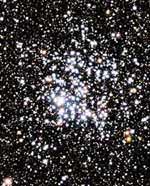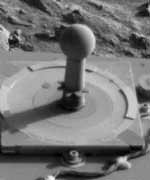
Image credit: NASA
Monday, November 1 – As the new month begins, we’ve already began to feel the impact of the shorter daylight hours and I am sure many of you have noticed the migration of the birds. What better time to explore the infamous “Wild Duck” cluster than in the short span of time we have tonight before the Moon rises?
Discovered in 1681 by German astronomer, Gottfried Kirch, at the Berlin Observatory, M11 was later cataloged by Charles Messier in 1764 and first dubbed the “Wild Ducks” by Admiral Smyth. To our modern telescopes and binoculars, there is little doubt as to how this rich galactic cluster earned its name – for it has a distinctive wedge-shaped pattern that closely resembles a flight of ducks. This fantastic open cluster of several thousand stars (about 500 of them are magnitude 14 or brighter) is approximately 250 million years old!

Image credit: NASA
M11 is easily located by identifying our last week’s study object – Altair. By counting two stars “down” the “body” of Aquila and stopping on Lambda you will find your starhop “guide”. Near Lambda you will see three stars, the centermost is Eta Scuti. Now just aim! Even small binoculars will have no problem finding M11, but a telescope is required to start resolving individual stars. The larger the telescope’s aperture the more stars will be revealed.

Image credit: NASA
Tuesday, November 2 – Tonight will be a great opportunity before the Moon rises to try your hand at finding Uranus and Neptune. Uranus will be fairly easy to spot in small binoculars just due west Sigma Aquarii. At a respectable magnitude 5.8, it will appear to this low power view as a blue/green “star”, but telescopes will reveal its 3.5″ disc with no problem. At magnitude 7.9, Neptune is harder to find, but not impossible in moderately dark skies.
The key to finding Neptune is to locate bright Alpha and Beta in Capricornus’ northwest corner. From there, drop due south to find a close grouping of three stars. Now go due west until you spot moderately bright Theta about central in the constellation. Theta will be your guide and you will find Neptune west/northwest of it by using a more detailed locator chart. Neptune will appear as a small (2.3″ diameter) blue-grey disk to higher power, but that’s pretty remarkable considering it’s over four and half billion kilometers away from the Sun!
Don’t think that’s challenge enough? Then large telescope owners and webcam “hot shots” are encouraged to try for Neptune’s most visible moon, Triton, at magnitude 13. Best of luck!

Image credit: NASA
Wednesday, November 3 – For those of you who have awaited the chance to find Saturn easily? Then tonight is your night. Rising by local midnight the waning Moon will be your guide to finding Saturn – for the “Ring King” will appear about 6 degrees south. (If you can’t stay up that late? Don’t worry! The pair will still be there before dawn.)
Saturn is absolutely magnificent in even the smallest of telescopes. Its amazing ring system and bright moon Titan are easily perceived at modest magnification and even larger binoculars will reveal its planetary nature. Larger telescopes will appreciate Saturnian features such as the Cassini division and shadow of the planet against the ring system.
Moon viewer’s will also appreciate tonight’s highlighted view of the Apennine Mountain range. Stretching a massive distance of 750 km (450 miles) the Apennine Mountain range makes up the south east wall of Mare Ibrium. Truly a delight!
***image6***On November 3, 1957 the Russian Space Program launched its first “live” astronaut into space – Laika. Carried on board Sputnik 2, our canine hero was the first living creature to reach orbit. The quickly developed Sputnik 2 was designed with sensors to transmit ambient pressure, breathing patterns and heartbeat of its passenger along with a television camera monitor. The craft also monitored ultraviolet and x-ray radiation as well to further study the impact of space flight upon human occupants. Unfortunately, the technology of the time offered no way to return Laika to Earth, so she perished in space. On April 14, 1958, Laika and Sputnik 2 returned to Earth in a fiery re-entry ending after 2,570 orbits.
***image7***Thursday, November 4 – Prepare yourself for this week’s exciting astronomical event! Before local sunrise this morning, bright Venus and returning Jupiter will make a dazzling appearance in the eastern sky as they appear around one half a degree apart! This spectacular display will delight viewers of all ages and skill levels. Very visible to the naked eye, this bright pairing will offer outstanding photographic opportunities and well as a memorable observing experience through either telescopes or binoculars.
This morning will be the peak of the Southern Taurid meteor shower. Already making headlines around the world for producing fireballs, the Taurids will be best visible in the earlier evening hours before moonrise. The radiant for this shower is, of course, the constellation of Taurus and red giant Aldeberan, but did you know the Taurids are divided into two streams? It is surmised that the original parent comet shattered as it passed our Sun around 20,000 to 30,000 years ago. The larger “chunk” continued orbiting and is known as periodic comet Encke. The remaining debris field turned into smaller asteroids, meteors and larger fragments that often pass through our atmosphere creating astounding “fireballs” known as bolides. Although the fall rate for this particular shower is rather low at 7 per hour, these slow traveling meteors (27km or 17 miles per second) are usually very bright and appear to almost “trundle” across the sky. With the chances high all week of seeing a bolide, this makes a bit of quiet contemplation under the stars a worthy evening.
While you are out meteor watching, take the opportunity to check out the Moon. Tonight’s highlighted features will be craters Pltomaeus, Alphonsus and Arzachel.
***image8***Friday, November 5 – Did you miss your opportunity to see Venus and Jupiter yesterday? Then don’t despair for the pair will still be very visible in the pre-dawn skies this morning as well. They’ve just changed positions slightly! Two additional challenges for this morning is the appearance of Mars low on the horizon and the return of Comet LINEAR C/2003 K4.
Viewers with an open horizon to the east/south east are strongly encouraged to take out even the smallest of binoculars or telescopes and attempt to find Comet K4 in the basic center of the constellation of Corvus. The four primary stars of Corvus are easy to recognize and finding the comet should be a cinch. The two southernmost stars are Beta and Epsilon – almost directly between them and slightly to the north is Theta. It is around this star your will find the comet! Starting November 1, K4 will be north of Theta and will be slightly southwest of it on this date. At predicted magnitude 5, this bright comet is on the verge of naked-eye visibility and will be a snap to find with binoculars.
For Moonwatchers tonight, take the opportunity to revisit the “Straight Wall”. While we learned about Rupes Recta during the waxing phase two weeks ago, the waning phase will create the finest appearance of the “Straight Wall” this month.
***image9***Saturday and Sunday, November 6 and 7 – Thanks to the later rise of the Moon this weekend, right now would be a great time to think “all about Andromeda”. The first of our objects for tonight can be a naked-eye observation from a dark sky site, an easy catch with binoculars even from urban locations and absolutely outstanding in telescopes. Of whom do I speak so highly? Why, of the Great Andromeda Galaxy of course!
For those of you just beginning in astronomy, you owe it to yourself to find a dark sky location and try locating a galaxy whose light left almost 3 million years ago with just your eyes! Although I have provided you with a map, it’s not always as easy to use one as it may seem. If you are having difficulties, try this simple trick. About an hour or so after the Sun sets and the skies are completely dark, go out and face east. About halfway between the horizon and the zenith, look for a wide pattern of four stars that resemble a large diamond. This is the Great Square of Pegasus! To the left of you, look for the flattened M of the constellation of Cassiopeia. Now, returning to the Great Square, focus on the left hand star and point at it. Moving left, count this as one bright star. Going left, two – a much dimmer one, and more left, three, a bright one – and stop. Above this star (and toward Cassiopeia) you will see another star, and above that? A hazy, fuzzy patch of glow that is the Andromeda Galaxy! As far back as 905 A.D., this galaxy has been known as “The Little Cloud” and appeared on ancient star charts long before the telescope was even dreamed of. It also appeared on Dutch starmaps as far back as 1500, but wasn’t cataloged by Messier until August 3, 1764. One of the first telescopic descriptions actually dates back to 1612! Even the great Edmond Halley in 1716 credited its discovery incorrectly to French astronomer Bullialdus in 1661, even though it had been reported 150 years earlier.
***image10***As a part of our own “Local Group” of eleven galaxies, the Andromeda galaxy is our nearest large neighbor. Both it and our own Milky Way are approaching each other at about 100 km per second. But not to worry – the M31 is still almost 2.9 million light years away!
Now, focus binoculars on the area and be prepared to journey across space and time…
Small telescopes and binoculars at low power will have no trouble seeing the M31’s bright nucleus and 4 degrees of extension. Larger binoculars and mid-range telescopes will find that the Andromeda contains a triple treat, as the M32 and M110 galaxies also accompany it. For those of you with large telescopes who scoff at such a simple target as the Andromeda? Then I highly encourage you to “power up” and study the NGC206 on the M31’s southern flank. This region of nebulosity and starbirth is a challenge object worthy of your optics and you’ll be studying a DSO in another galaxy!
While you’re in the neighborhood? Take the time to study the map and visit with Gamma Andromeda. Almach is a wonderful double star, and its yellowish primary and blue-green secondary are easily split by modest telescopes. Again, for those of you with larger telescopes and precision optics there’s another challenge here. Almach’s secondary star is also a double!
Until next week fellow stargazers? Keep looking up! I wish you clear skies and light speed… ~Tammy Plotner



